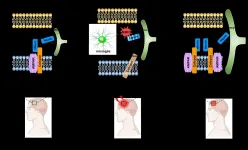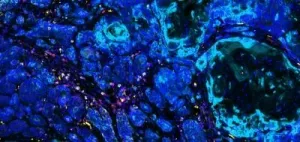Novel interactions between proteins that help in recovering from brain injury
Neuroinflammatory response-induced proteases impede the recovery process from brain injury; novel interactions between proteins (hevin and calcyon) help in the recovery of neurons in a mature brain
2021-06-19
(Press-News.org) Patients with brain injury (caused by stroke or trauma) primarily rely on rehabilitation therapy for recovery, as there are no other known effective treatment methods. The rate of recovery from brain injury observed in adults is significantly slower (or the recovery is impossible) than that observed in young children. The consensus among researchers is that the number of excess neural stem cells capable of restoring brain functions is lower in a mature brain than that in the brain of young children.
A Korean research team reported a novel mechanism to describe the brain injury recovery process. The researchers reported that when the animal model experiment was conducted, the time taken to recover from a brain injury could be controlled by regulating the proteins. The Korea Institute of Science and Technology (KIST) has released an announcement that a team led by Dr. Eun Mi Hwang of the Brain Science Institute, KIST collaborated with another team led by Prof. Kyoungho Suk of the School of Medicine, Kyungpook National University and reported the presence of a novel interaction between proteins (hevin-calcyon); this interaction plays a critical role in the brain injury recovery process in adults. The researchers also revealed that this interaction plays an important role in the early stages of recovery.
The researchers working at KIST identified the calcyon protein as a novel interaction partner of hevin, a protein secreted by the glial cells present in the brain. They also reported that the interaction between the proteins played a critical role in the recovery process of neuronal cells present in an injured adult brain. As neurons are cells that directly influence brain activity, it is believed that brain diseases can be cured when they are recovered and/or treated.
*Glial cells : Cells that support the tissues of the central nervous system, provide nutrients to neurons inside the brain and spinal cord, and create a chemical environment suitable for the activities of neurons
The results from the experiments revealed that an increase in the number of hevin-calcyon interactions in the brain could promote synaptic contacts and reorganization, which could help in the early recovery of the impaired brain. The hevin-calcyon interaction and the expression of these proteins were confirmed by studying healthy brain tissues. It was also observed that the number of interactions in patients suffering from the condition of traumatic brain injury was significantly reduced.
Researchers at the Kyungpook National University studied the recovery process of brain injury by studying the hevin and calcyon interaction using a brain injury animal model. They reported that the neuroinflammatory response-induced proteases formed in the early stages of brain injury resulted in the fragmentation of hevin. This also impeded the generation of the hevin and calcyon interaction. Experiments were conducted using an animal model of brain injury. It was observed that the recovery time could be reduced to approximately 2 to 3 weeks (from 4 weeks) if an inflammatory response inhibitor was administered directly to the injured region of the brain. The rate of recovery could be further slowed by administering an additional inflammatory protein.
The joint research team reported that the absence of the hevin-calcyon interaction in the early stages (a critical period in the recovery process of brain injury) of the recovery process might negatively impact the effective recovery process. The reported result is the outcome of the five years of persistent efforts by the team led by Dr. Eun Mi Hwang of KIST (this team identified the novel interaction between proteins), team led by Dr. Hoon Ryu of KIST (this team investigated human traumatic brain injury), and team led by Prof. Kyoungho Suk of the Kyungpook National University (this team studied the properties of inflammation using various animal models). Each team contributed to the findings based on their area of expertise.
Dr. Eun Mi Hwang of KIST said, "The hevin-calcyon interaction can potentially help in treating brain diseases as brain injury and neurodegenerative diseases can result in the generation of inflammatory responses." She also added, "The findings can potentially help in the development of procedures for treating refractory brain diseases caused by impaired synaptogenic activity."
INFORMATION:
This research was conducted as a part of the Core Technology Development Project in Neuroscience funded by the National Research Foundation of Korea and supported by the Ministry of Science and ICT (MSIT). The results were published in the latest issue of "Cell Death & Differentiation" (IF: 10.717, top 6.229% in JCR), an international academic journal.
[Attachments] See images for this press release:

ELSE PRESS RELEASES FROM THIS DATE:
2021-06-19
Globally, an estimated 10 million people develop tuberculosis (TB) each year and the disease remains a leading cause of death from a single infectious agent. Standard short-course anti-TB treatment still requires a regimen of at least six months of antimicrobial drugs, and drug-resistant TB is an increasing public health threat. Even after the traces of TB disease are quashed, patients often suffer from significant sequelae, such as lung scarring. TB survivors have approximately three to four times greater mortality than their local population.
In pulmonary TB, the most common form of active TB disease, the ...
2021-06-19
(Vienna, Saturday, 19 June 2021) Music by Mozart has been shown to have an anti-epileptic effect on the brain and may be a possible treatment to prevent epileptic seizures, according to new research presented today at the 7th Congress of the European Academy of Neurology (EAN).
Researchers believe that the acoustic (physical) properties within the music are responsible for this effect.
Listening to the famous 18th century composer's Sonata for Two Pianos K448 led to a 32% reduction in epileptiform discharges (EDs). These are electrical brain waves associated with epilepsy and can cause seizures or bursts of electrical activity that temporarily affect how the brain works.
A team led by Professor Ivan Rektor, from the Epilepsy Centre ...
2021-06-19
Highlights
Primary nephrotic syndrome is characterized by high urinary excretion of protein, low protein in the blood, high cholesterol, and swelling in the arms and legs.
A new analysis highlights the high risk of kidney failure and different cardiovascular complications in patients with primary nephrotic syndrome.
Washington, DC (June 18, 2021) -- A form of kidney disease called primary nephrotic syndrome is characterized by high urinary excretion of protein, low protein in the blood, high cholesterol, and swelling in the arms and legs. Patients may face a range of negative health outcomes, but the extent of these effects are unknown. In a study appearing in an upcoming ...
2021-06-19
Highlights
In a study of patients waiting for a kidney transplant, those who experienced various symptoms had a higher risk of dying while on the waitlist.
Symptoms tended to increase or remain unchanged between transplant evaluation and transplantation; however, at 3 months after transplantation, 9 of 11 symptoms lessened.
Washington, DC (June 18, 2021) -- Investigators have examined how various symptoms experienced by individuals with kidney failure are impacted by kidney transplantation. The findings will appear in an upcoming issue of CJASN.
People with kidney failure must often deal with numerous symptoms, such as fatigue, cramping, muscle soreness, numbness, dizziness, and loss of appetite. Although kidney transplantation ...
2021-06-19
New findings published this week in Physical Review Letters suggest that carbon, oxygen, and hydrogen cosmic rays travel through the galaxy toward Earth in a similar way, but, surprisingly, that iron arrives at Earth differently. Learning more about how cosmic rays move through the galaxy helps address a fundamental, lingering question in astrophysics: How is matter generated and distributed across the universe?
"So what does this finding mean?" asks John Krizmanic, a senior scientist with UMBC's Center for Space Science and Technology (CSST). "These are indicators of something interesting happening. And what that ...
2021-06-18
Just as the skeleton and muscles move the human body and hold its shape, all the cells of the body are stabilised and moved by a cellular skeleton. Unlike our skeleton, this cellular skeleton is a very dynamic structure, constantly changing and renewing itself. It consists of different types of protein filaments, which include intermediate filaments and microtubules. Now, a research team from the University of Göttingen is the first to succeed in observing a direct interaction between microtubules and intermediate filaments outside the cell, and also in quantitatively measuring this interaction. The results of the study were published in Nature Communications.
Microtubules are dynamic filaments ...
2021-06-18
Study Highlights
New research reveals how key proteins interact to regulate the body's response to stress
Targeting these proteins may help treat or prevent stress-related psychiatric disorders
The biological mechanisms behind stress-related psychiatric conditions, including major depressive disorder and post-traumatic stress disorder (PTSD), are poorly understood.
New research now details the interplay between proteins involved in controlling the body's stress response and points to potential therapeutic targets when this response goes awry. The study, which was conducted by an international team led by investigators at McLean Hospital, appears in ...
2021-06-18
BOSTON - Researchers from Massachusetts General Hospital (MGH) have discovered a biological mechanism that transforms cells exposed to carcinogens from environmental factors like smoking and ultraviolet light into immunogenic cells that can be harnessed therapeutically to fight treatment-resistant cancers. As reported in Science Advances, that mechanism involves spurring the release of small proteins known as chemokines which, in turn, recruit antitumor immune cells (CD8+ T cells) to the tumor site to block metastasis, potentially enhancing the effectiveness of a new generation of immunotherapies.
"Immunotherapeutics ...
2021-06-18
CHICAGO --- Scientists have long known the brain's hippocampus is crucial for long-term memory. Now a new Northwestern Medicine study has found the hippocampus also plays a role in short-term memory and helps guide decision-making.
The findings shed light on how the hippocampus contributes to memory and exploration, potentially leading to therapies that restore hippocampal function, which is impacted in memory-related aging and neurodegenerative diseases such as dementia, the study authors said.
In the study, scientists monitored participants' brain activity and tracked their eye movements while looking at different complex pictures. The scientists discovered ...
2021-06-18
Birds build nests to keep eggs and baby nestlings warm during cool weather, but also make adjustments in nest insulation in such a way the little ones can keep cool in very hot conditions. Mammals, such as rabbits or groundhogs, sleep or hibernate in underground burrows that provide stable, moderate temperatures and avoid above-ground conditions that often are far more extreme outside the burrow.
Michael Dillon, an associate professor in the University of Wyoming Department of Zoology and Physiology, was part of a research group that examined animals' ability to respond to climate change likely depends on how well they modify their habitats, ...
LAST 30 PRESS RELEASES:
[Press-News.org] Novel interactions between proteins that help in recovering from brain injury
Neuroinflammatory response-induced proteases impede the recovery process from brain injury; novel interactions between proteins (hevin and calcyon) help in the recovery of neurons in a mature brain



